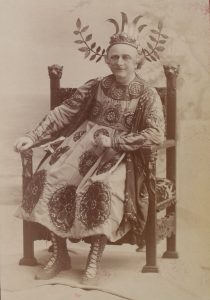Written by Graham Billing, co-director of La Belle Hélène.
Last time I set down some thoughts about the way in which Offenbach and his two script-writers Meilhac and Halévy turned serious figures from Greek mythology into comic characters in La Belle Hélène. This time I’m going to continue with this theme and discuss the operetta’s central love interest.
In France in the nineteenth century farce was coming more and more to the fore – farce being the type of comedy in which one false move early on plunges the characters into a situation over which they have less and less control and which forces them to try and keep one step ahead of the game by allowing themselves to be more and more humiliated.
Not surprisingly, the situations in question often involve extra-marital love affairs. The classic comedy plot, which goes back to the Romans, if not further, sees a young and passionate woman married, usually against her will or at any rate with no great enthusiasm, to an unsuitable husband who is old or daft or both and cannot satisfy her between the sheets. A younger, more intelligent and definitely more virile partner is bound to turn up and adultery is on the point of being committed when the two participants are obliged to go into hiding or on the run by the unexpected reappearance of the husband. Actually, it may be the girl’s father, or the boy’s father, or even the boy’s wife, but it’s always someone against whom the naughty couple have offended and whose wrath they need to flee.

Albert Brasseur as Ménélas in La Belle Hélène – 1899
Most people know that one of the key Greek sagas concerns the Trojan War, started by the Greeks to avenge the fact that their Princess Helen was abducted from her husband Menelaus by Paris, the son of King Priam of Troy. What the script of La Belle Hélène does is to fuse this saga with the archetypal French farce, making Paris into a suave and irresistible seducer, Helen into a woman who is about to explode with sexual frustration and Menelaus into a timid and dithery buffoon. Albert Brasseur, who played the role in the 1899 revival, looks the part to perfection!
Written by Graham Billing, co-director of La Belle Hélène.
Last time I said that part of the audience appeal of La Belle Hélène lies in the way in which the script pokes fun at ancient Greek myths and the fact that the French have always taken them so seriously. Let’s take two of the main characters in the show and explore what happens to them when they get swept into Offenbach’s crazy world.
These two characters are the Greeks’ great ruler and general Agamemnon, known as the King of Kings, and his son Orestes. The French would have known about them not just from studying ancient Greek writers such as Aeschylus and Euripides, but because they both turn up in plays by the great French tragedian Jean Racine.
Tragedian… Well, yes, Racine seized on the fact that Agamemnon and Orestes are both victims of the most appalling fate. Agamemnon led the Greeks into the devastating Trojan War and did not even stop at sacrificing his own daughter Iphigenia to the sea-god Poseidon in return for a favourable wind to take the Greek fleet to Troy. After ten years of fighting, he returned home, only to be murdered in his bath by his wife Clytemnestra in revenge for his willingness to kill their child.
Young Orestes, his son, was now placed by the gods in an impossible no-win situation. On the one hand they imposed on him the sacred duty of avenging the death of a parent by killing that parent’s killer; on the other they would condemn him for the appalling offence of killing a parent, since one of his parents had killed the other. After much soul-searching, Orestes did avenge his father’s death by killing his mother and her lover, but the gods punished him with insanity brought on by guilt, in the form of being haunted by the horrific spirits called the Furies.
Grim stuff, eh? Not in the hands of Offenbach and his two script-writers. They turn Agamemnon into a pompous and sarcastic establishment figure, whose only weakness is that he is scared stiff of the nagging wife he always manages to escape. And their pre-war Orestes is a precocious teenage party animal who celebrates all night with a gang of bad girls and is always trying to wheedle more pocket money out of his father. To emphasise just how precocious – and immature – their Orestes is, they decree that he should be played by a young and wacky soprano, thus becoming one of the first ever principal boys – or, if you prefer, examples of gender-fluid casting.
Irreverent and impudent? Definitely!
Banner images left to right: Ève Lavallière as Orestes (1889), statue of Orestes, Agamemnon’s mask, Victor Sandstedt as Agamemnon (1865)


